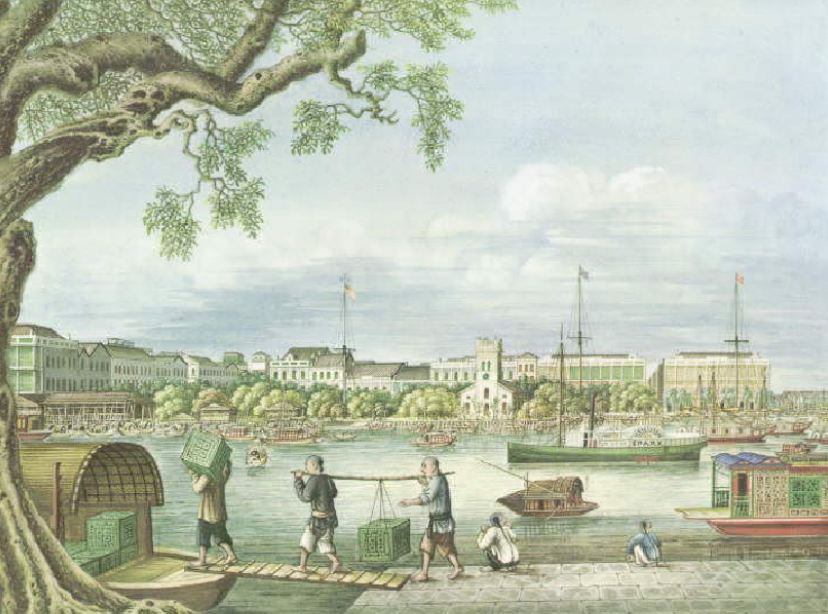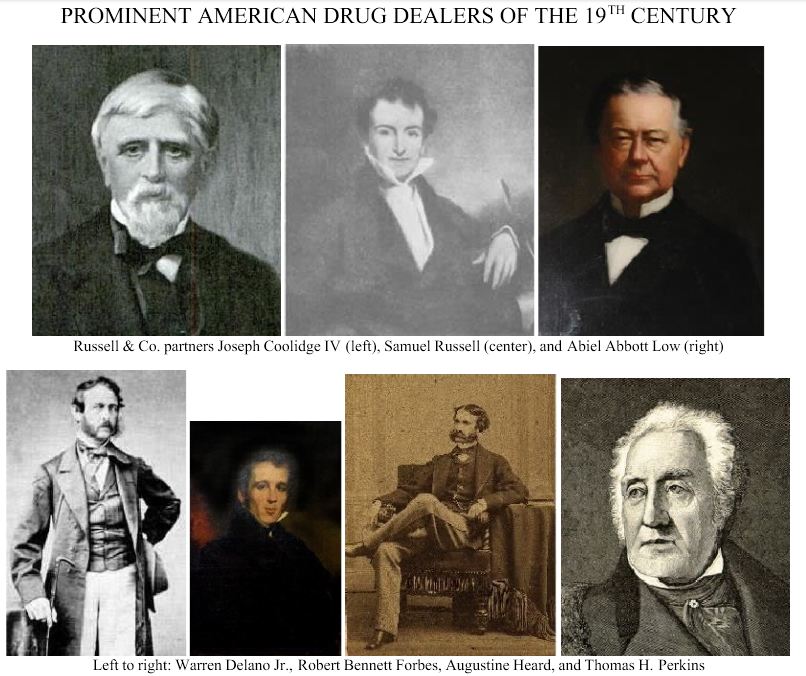Contents
- Introduction
- Preface
- Overview
- Relief Valve
- LECTURE 1: Why We Are In The Dark About Money
- LECTURE 2: The Con
- LECTURE 3: The Vatican-Central to the Origins of Money & Power
- LECTURE 4: London The Corporation Origins of Opium Drug Smuggling
-
LECTURE 5: U.S. Pirates, Boston Brahmins Opium Drug Smugglers
-
THE BOSTON BRAHMINS
- Clipper Ships
- The Boston Money Tree
- John Perkins Cushing
- Abiel Abbott Low
- William H. Russell and Samuel Russell
- The Combination Russell, Jardine, and Matheson
- Russell Sturgis
- Colonel Thomas Handasyd Perkins
- The Perkins Family
- Frances Perkins--The Only Good Brahmin
- American House of Russell and Co.
- Harvard Corporation
- Opium to Brahmins to Yale to CIA
- Forbes Family I
- Warren Delano
- Hope & Co. - Baring Brothers Bank
- John Jacob Astor
- Taft Family
- 1924 America's 1% Exposed
- Proof FDR Knew About his Grandfather's connection with Opium China Trade
- Forbes - John Kerry Family II
- George Bush Family Origins in Opium Drug Smuggling
- Black Market Bones
- Thuggee Barbara Bush Family
- Thuggee Bush Family and the CIA
- John Quincy Adams and the Chinese Opium Trade
- The Ammidons
- Augustine Heard
- Joseph Coolidge IV
- Lowell Family
- Pirates Profiteers Banksters Traders Transfers
- Pirates
- White Slavers, Cargo, Property, Auctions, Amazing Grace
- $ Colonial Labor: Indentured Servants
- England to Philadelphia Slave Trade and Opium
- Extract from Charter of Freedoms and Exemptions to Patroons 1629
- The Definitive Treaty of Peace
- Pennsylvania Charter of Privileges 28 October 1701
- Opium Trade -- American Drug Smuggling Pirates
- Opium In America
- 1% Power Elite Networks
- 1% Elite Networks Bush & The CIA
- BEFORE Skull & Bones
- SKULL AND BONES
- Caribbean Pirates in the American South
- Who Were the Tories
- The Golden Age of Imperialism Opium Act 1908
- Global Dominance Groups
- The New World Order
- Characteristics of Fascism
- War on drugs
- Lecture 5 Objectives and Discussion Questions
-
THE BOSTON BRAHMINS
- LECTURE 6: The Shady Origins Of The Federal Reserve
- LECTURE 7: How The Rich Protect Their Money
- LECTURE 8: How To Protect Your Money From The 1% Predators
- LECTURE 9: Final Thoughts
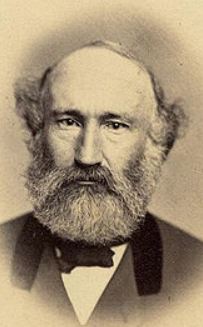 Banks and Opium and Yale
Banks and Opium and Yale
William H. Russell founder of the Yale University secret society Skull and Bones.
He was a descendant of several old New England families, including those of Pierpont, Hooker, Willett, Bingham, and Russell. His ancestor Rev. Noadiah Russell was a founder and original trustee of Yale College.
In 1828, William's father died, piling family responsibility on to him. Under severe financial restraints, he entered Yale College. He supported himself throughout his college years. In 1823 Samuel Russell, his cousin founded Russel & Co.
The Order of Skull and Bones is a secret society founded at Yale by William Huntington Russell (S&B 1833). His cousin Samuel Russell's family enterprise, Russell & Company, was the largest American opium smuggler, working with the Scottish firm Jardine-Matheson, the world's largest.
Many New England and Southern families in the "China Trade" (aka opium smuggling) sent their sons to Yale, and many were "tapped" into Skull and Bones. From Yale, "Bonesmen" went into and were very influential in the worlds of commerce, communications, diplomacy, education, espionage, finance, law and politics.
Skull and Bones was created to keep the drug money in the pockets of this wealthiest 1%.
he wanted to become a minister. . . but ended up becoming america's biggest drug dealer. how's that for hypocrisy?
Russell had planned on entering the ministry, but his financial problems forced him to obtain an immediate income through teaching. In September 1836, he opened a private prep school for boys in a small dwelling house. The school would become known as the New Haven Collegiate and Commercial Institute. To begin with, the school was only attended by a small number of boys, but by the time of Russell's death the school had become well known and had graduated around 4,000 boys. In about 1840, Russell introduced a very thorough military drill and discipline into his school. He foresaw a Civil War in the future, and wanted to make sure his boys were prepared to fight for the Union. His students were so well schooled in military affairs that on the outbreak of Civil War some were enlisted as drill instructors.
He not only gave his students to the Union army, but also his own services. Governor Buckingham realized that Russell was one of the most knowledgeable men in military affairs. For this reason, Russell was hired to organize the Connecticut militia. He was later made a major-general by act of the legislature.
From 1846 to 1847, Russell served as a Whig in the Connecticut state legislature. Upon the repeal of the Missouri Compromise in 1854, he became active as one of the leaders of the movement which resulted in the organization of the Republican Party. He was a strong abolitionist and a friend of John Brown. Russell was named as a trustee in the will of John Brown. He was also the Connecticut representative on the National Kansas Committee.
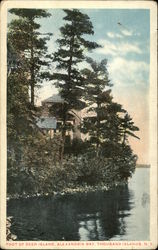
In 1856, with several other Bonesmen, he incorporated Skull and Bones as the Russell Trust, later the Russell Trust Association.
The Russell Trust Association is a tax-exempt association; holds possession of the Skull and Bones Hall at Yale University and the society's holiday island, Deer Island.

Russell Company founded with Philip Ammidon
Samuel Russell In 1823, using the old pirates’ ‘Skull & Crossbones’ as its logo, Samuel Russell founded an opium-smuggling company, Russell & Co. – and by 1829, he had bought out the Perkins & Co., which had controlled the smuggling of Turkish opium into China since 1789. In 1833, Samuel’s second cousin, William Huntington Russell and Alphonso Taft (who had served as Secretary of War under President Rutherford B. Hayes) founded the Order of Skull & Bones.
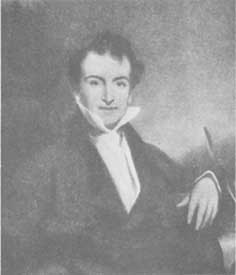 Sam was William Russell's cousin!
Sam was William Russell's cousin!
In 1823 Samuel Russell founded Russell & Co.
Samuel Wadsworth Russell House
National Historic Landmark #29
350 High Street, Middletown, quasi-public
Middlesex County, CT
Son of Capt. John Russell and Abigail Warner, Russell was orphaned at the age of 12, did not receive any significant inheritance, and did not attend college. Instead, he began his career as apprentice clerk for a maritime trade merchant, Whittlesley & Alsop, in Middletown. It is there that Russell began learning his skills as a trader. In 1810, his apprenticeship having ended, he moved to New York where he hoped to prosper. In 1812, he joined Hull & Griswold, a merchant house, based in New York but established by investors with family ties in Connecticut. He began traveling on company ships as supercargo and soon began trading on a commission basis which enabled him to found his first company, Russell & Company, a commission trader for Hull & Griswold, in his hometown of Middletown.
Attracted by financial prospects, Russell set out for China, an assured profitable venture. He arrived in Canton, China, in 1819, engaging in trade on behalf of the Providence firm of Edward Carrington & Company in various goods and products including opium, an extremely profitable activity despite being outlawed-yet protected by foreign forces.
The profits made by Russell enabled him to found Russell & Company in Canton, China, in 1824. Dealing mostly in silks, teas and opium, Russell & Company prospered, and by 1842, it had become the largest American trading house in China. It kept its dominance until its closing in 1891. Russell withdrew from the company in 1836. He returned to America, and lived in his mansion in his hometown of Middletown, Connecticut, until his death in 1862. The mansion, now bearing the name of Samuel Wadsworth Russell House, (his son's name, Samuel had no middle name) had an elaborately-decorated interior; Russell had brought back many souvenirs and antiques from China, as well as gifts from his Chinese trade partner, Howqua.
In 1823, Samuel Russell established Russell and Company for the purpose of acquiring opium in Turkey and smuggling it to China.
Russell and Company merged with the Perkins (Boston) syndicate in 1830 and became the primary American opium smuggler. Many of the great American and European fortunes were built on the "China"(opium) trade.
One of Russell and Company's Chief of Operations in Canton was Warren Delano, Jr., grandfather of Franklin Roosevelt.
- Russell and Company merged with the Perkins (Boston) syndicate in 1830 and became the primary American opium smuggler.
- BOSTON BRAHMIN Colonel Thomas Handasyd Perkins December 15, 1764-January 11, 1854
- Delano was in business with the richest Pirate Opium Drug Smuggler of them all The PERKINS Family of Hillmorton, Warkwickshire, England, Ipswich, Essex, MA and Norwich, New London, CT.
- Franklin Delano Roosevelt's Grandfather Warren Delano II was a Pirate Opium Drug Smuggler.
- Edward Delano and Warren Deleno from New Bedford, CT were both Pirate Opium Drug Smugglers.
- Warren Delano II, was the head of Russell & Company, the biggest American firm in the China trade,"The opium trade is remembered as a British outrage: English merchants, protected by English bayonets, turning China into a nation of addicts. But Americans got rich from this traffic—among them, a young man named Warren Delano. He didn't talk about it afterward, of course. And neither did his grandson, Franklin Delano Roosevelt."
it's important to know that THIS drug money created the "prestigious" ivy league
Other Russell partners included
- John Cleve Green financed Princeton
-
Abiel Low (financed construction of Columbia See Early Columbia College Timeline, 1784-1857 - See Early Columbia University Timeline,
1858 - 1901
1866 -- College's endowment of $2,250,000 makes Columbia the richest college in the country (Harvard a distant 2nd with $1,000,000 endowment) they try to hide where the endowment came from.
June 4 -- President Barnard's 2nd Annual Report presents a statistically-grounded argument on the "Declining Popularity of Collegiate Education" - 1881 November 7 -- 31-Year-old Seth Low (CC 1870) elected Trustee; same week as he was elected reform Mayor of Brooklyn.
- 1889 October 7 -- Trustee (since 1881) and Columbia College graduate (CC 1870 ) Seth Low elected 11th president of Columbia College
- 1890 -- February 3 -- Seth Low inaugurated as Columbia's 11th president (to 1901)
- 1895 -- May 6 -- President Low announced to fellow Trustees his gift of $1,000,000 to construct library in honor of his father, Abiel Abbot Low
- Joseph Coolidge (Coolidge's son organized the United Fruit company, and his grandson, Archibald C. Coolidge, was a co-founder of the Council on Foreign Relations.)
- and the Perkins, Sturgis and Forbes Family
- Forbes Family Papers 1732-1931Guide to the Microfilm Edition Sponsored by the National Historical Publications and Records Commission.
Image Sources: 1) Smuggling ships, Columbia University; 2) Canton factories, Columbia University; 3) Opium wars fighting, Ohio State University; 4) Attack of clipper ships, Columbia University; 5) Treaty of Nanking, Ohio State University; 6) 19th century map of China, Columbia University.
the russells' key roles in pushing drugs on china against the nation's will
The Clipper Ships of the Boston-based “Russell and Company”, the great opium smuggling House in New England which later bought out its competition in Connecticut and Massachusetts, became lucrative assets for the family's shipping business, and, as opium smugglers, their activities under British orders helped to bring on the Opium Wars of the early-to-mid 1800s. The Bund No. 6 was the FIRST bank in China founded 1897 by Opium Drug Smuggling Pirate Russell. It was built as the headquarters for one of the most illustrious American companies to operate in China in the 19th century the powerful American traders Russell & Co, one of the earliest and most famous "Shanghailanders" on the Bund, trading in opium, tea, silk, porcelain and other items.
Russell Banks in Shanghai
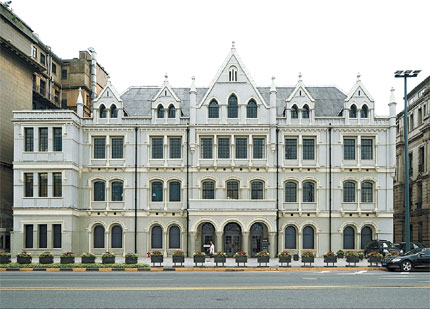
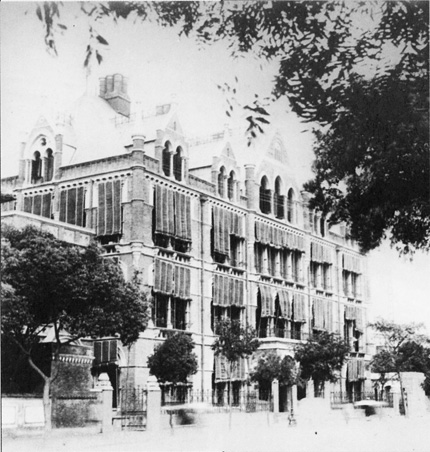
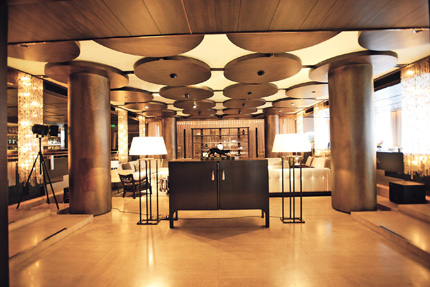
the russell and perkins firms joined forces to take U.S. DRUG TRADE TO ANOTHER LEVEL
The Russell and Perkins Alliance
The firm was founded in 1818 by Samuel Russell, of Middletown, Conn., and was first known as Samuel Russell & Co. In 1824 the firm became Russell & Co., and had a career rarely equaled in the Chinese trade.
John Perkins Cushing, who had been a representative of J. & T. H. Perkins in China, was one of those who had much to do with the starting of the firm, as he transferred to Russell & Co. a portion of the commission business which had grown too large for Perkins &Co. to handle.
The cause of the Opium War, which interrupted trade for a time, was a peculiarly flagrant piece of smuggling, which so aroused the Chinese government that its commissioner appeared at the foreign settlement, demanded the opium, and dumped it into the ditches.
The trouble was finally adjusted by England compelling China to pay an indemnity, and trade was resumed. The opium had been brought for some time from India in the swift-sailing vessels, or “clippers,” we have already described, and was smuggled into Canton by various means. As all foreigners lived in a narrow suburb on the river and were never allowed within the city, business was transacted with Chinese middlemen, one of whom, Houqua, was ever the warm friend of Russell & Co.” – Some Ships of the Clipper Ship Era: Their Builders, Owners, and Captains by The State Street Trust Company (1913), p. 9-10“John Perkins Cushing, called “Ku-Shing” by the Chinese, sailed for China when only sixteen years old, to take the position of clerk in the counting-house of his uncle, Colonel Thomas Handasyd Perkins. The head of the firm in China at this time was Ephraim Bumstead, who was soon obliged to leave Canton on account of illness, and died at sea. Young Cushing, therefore, arrived in China at this early age to find that he was the only representative of the Perkins firm in the East. Colonel Perkins, on hearing of Mr.Bumstead’s death, at once prepared to go to China, but just before sailing he received letters from the young apprentice, who presented the condition of affairs in such a favorable light that the intended journey was abandoned. Cushing managed the affairs of the firm so skillfully that the consignments continually increased. He was soon taken into partnership with the Perkinses and continued with them until the consolidation of their firm with Russell & Co. in 1827.”
this flag was a fitting tribute to these sociopath pirate drug dealers
RUSSELL AND COMPANY ships flew the black and white flag of the Skull and Bones, the Company's logo.
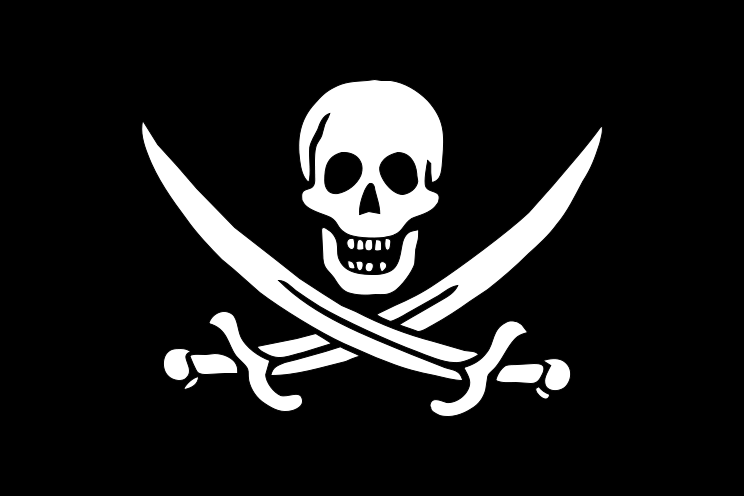
THE FINAL DAYS OF RUSSELL AND CO.
The Company loses its edge because it can no longer smuggle drugs illegally!
Spanish traders had joined with American and British traders in the early decades of the 1800s and Manila in the Philippines harbored several trading houses. These were used as offshore support and subterfuges in the opium smuggling dealings and "posturing."
The discovery of gold in California brought more dynamics, increased clipper ship activity and a renewed impetus for transcontinental railroads—which were financed a great deal by opium profits from investors in America, Britain and Scotland.
The second Opium War led to the legalization of opium in China in 1858 and the "country traders" began to lose their control. They were smugglers warehousing the "product" offshore and trying to control the flow—for maximum profits. Once the product was legalized the Chinese and Indian merchants started to take over the trade. Russell & Co. and others because of their role as smugglers had not developed a structure to sell opium in inner China. The Chinese brokers could now just order opium as any commodity and the trade was transferred to firms with strong ties at the producing base, India, and the consuming behemoth, China. Russell & Co. formed the Shanghai Steam Navigation Company and by 1874 they had 17 steamships—the largest fleet in Shanghai. Russell & Co. sold the Shanghai Steam Navigation Company to the China Merchant’s Steam Navigation Company in 1877 and the American share of Chinese shipping dropped by 80%. Russell & Co. is listed in some sources as failing in 1891 with British and German firms taken over their business. The Chinese Government an associate of Russell & Co. in the coast and ocean trade "lost heavily." According to some, the Russell & Co. successor in Shanghai was Shewan & Tomes.
4/14/14 1 YEAR LATER --- BOSTON BOMBER and the RUSSELL FAMILY CONNECTION
Tamerlan Tsarnaev is married to Katherine Russell of North Kingstown, Rhode Island
https://archive.is/oPOpY
Tsarnaev Wife Katherine Russell and Her Skull and Bones, CIA Family Connections
As more insights into the life and death of dead Boston Bombing suspect Tamerlan Tsarnaev continues to unfold, based on the available evidence – it’s becoming more and more obvious that he was either an FBI and/or CIA informant (or both), who was chosen to be set up as a fall guy, or patsy for the Boston Bombings. In this instance, he would also have needed a “handler” – someone who could help to steer and influence his day-to-day decision making. That person could be someone was very close to him.
“CONFIRMED: Katherine Russell (alleged bomber’s wife) is granddaughter of Richard Warren Russell, Skull and Bones member and entrepreneur in the energy industry. Richard Russell was a member of U.S. Army Counter-Intelligence during the 1950s. Going back yet one more generation, Katherine's great-grandfather was also a graduate of MIT and served as General Manager of a steel corporation. The Russells are a well-established family with captains of industry and graduates of Ivy League and other highly regarded schools at both the high school and collegiate levels. The media also reported that Warren Russell studied at Phillips Exeter Academy, one of the leading prep schools in the nation, and Yale.
Like his Uncle Ruslan, Tamerlan Tsarnaev had wife with high level connections to US intelligence. Russell’s obituary lists Warren King Russell II as son – and that’s Katherine’s emergency room doctor father. That means wife had family spook connections as well as husband Tamerlan (Uncle Rusla). And both had fast, dramatic and uncharacteristic conversions to a perverted form of Islam favored by the gangster family that runs Saudi Arabia and works hand in hand with our spooks.
Boston Bombing Clues: Who is Uncle Ruslan?
The uncle of Boston’s two Tsarnaev brothers worked for the CIA-front organisation called USAID… Was Boston Bombers ‘Uncle Ruslan’ with the CIA? Obama’s mother also worked for USAID, while being in the CIA, reportedly.
The uncle of the two men who set off bombs at the Boston Marathon, who struck the only grace note in an otherwise horrific week, worked as a “consultant” for the Agency for International Development (USAID) a U.S. Government Agency often used for cover by agents of the CIA, in the former Soviet Republic of Kazakhstan during the “Wild West” days of the early 1990’s, when anything that wasn’t nailed down in that country was up for grabs.
**Coincidence: Alleged Bomber’s Widow Is Granddaughter of Skull & Bones Member
1. Richard W. Russell (Katherine Russell’s grandfather), is mentioned on Eric Samuelson’s Skull & Bones membership list, which might be a list similar to the one Anthony Sutton mentioned but never published. Scroll down to, “Russell, Richard Warren 1951.”
Russell Richard Warren 1951
Russell William Huntington 1833
A graduate of Phillips Exeter Academy, Yale University and a graduate student at the Massachusetts Institute of Technology,
2. Richard W. Russell had a son named, Warren Russell: He is survived by Katherine Wehmann Russell, his wife of 56 years; his children Dr. Warren King Russell II, Elizabeth Suzanne Russell, Margaret Warburg and Richard Andrew Russell…
3. Dr. Warren Russell is Katherine Russell’s father: Russell grew up in North Kingstown, Rhode Island, the oldest of three girls. Her father, Dr. Warren Russell, is an emergency physician; her mother, Judith, is a nurse. Widow of alleged Boston bombing suspect now appears to be of the same Russell bloodline that was the founders of the Skull and Bones Society. The Russell Trust Association is the business name for the New Haven, Connecticut based Skull and Bones society that was incorporated in 1856.
Tamerlan (the older brother) who died in crossfire with the authorities and Dzhokhar, who has plead not-guilty and awaits trial. The parents of the brothers [Anzor (the father) and Zubeidat (the mother)] as well as two uncles [Alvi Tsarnaev and Ruslan Tsarni] have all have been in the media spotlight, giving various explanations for the brothers' actions or denying their involvement.
The Russell family. Older brother, Tamerlan Tsarnaev, married an American woman named Katherine Russell, the oldest of three sisters and with whom he had a daughter. Katherine's father, Warren, is an emergency room doctor with medical licenses in multiple states while her mother, Judith, has practiced nursing and social work. Her father, Warren Russell, is an emergency doctor whose Facebook profile lists his high school alma mater as the elite New Hampshire boarding school Phillips Exeter Academy and college as Yale. Her mother, Judith Russell, was listed on her Facebook profile as working at a social services agency. Katherine Russell got pregnant by Tamerlan and dropped out of high school. Katherine's father and grandfather both went to Phillips Exeter Academy and Yale. Grandfather was a member of Skull and bones Katherine's great-grandfather was also a graduate of MIT and served as General Manager of a steel corporation. Dr. Warren K. Russell, MD Emergency Medicine 100 Kenyon Ave, Wakefield, RI 02879 her father Warren Russell MD. Pictures Judith Russell, Katherine's mother The Russell family home in North Kingstown, Rhode Island, where Katherine is staying Amato DeLuca Family attorney Katherine Russell's family, about which the media seemingly did little research, much less provide coverage. Aside from Katherine Russell's parents being an ER doctor and a nurse, respectively, a deeper investigation into the family provides clues to why Katherine might have removed herself from her family. https://archive.is/ruZWB
READ THE SECRET HISTORY OF THE AMERICAN EMPIRE BY JOHN PERKINS
